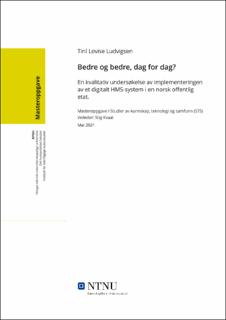Bedre og bedre, dag for dag?
Master thesis
Permanent lenke
https://hdl.handle.net/11250/2781839Utgivelsesdato
2021Metadata
Vis full innførselSamlinger
Sammendrag
Målet med masteroppgaven er å utforske digitaliseringen av arbeidslivet medutgangspunkt i implementeringsprosessen av et nytt digitalt HMS-system ved en norskoffentlig etat. Oppgaven tar for seg hvorfor systemet ble innført, hvordan det bleutformet og hvordan det ble tatt i bruk av de ansatte i etaten. Andre viktige faktorer somogså tas opp er ledelsens engasjement og brukernes tilnærming til systemet.Masteroppgaven er basert på kvalitativ metode, og datamaterialet består hovedsakeligav en spørreundersøkelse med syv informanter, og dybdeintervju med seks informanter.Oppgavens problemstilling er: «Hvordan ble avviks- og forbedringssystemet Innmelderoimplementert og tatt i bruk i en offentlig norsk etat?». Teoriene som brukes for å besvareproblemstillingen og underspørsmålene i oppgaven er script-teori og domestiseringsteori.Systemet og dets script ble utviklet for å i størst mulig grad tilpasses de ansatte somsluttbrukere av teknologien. Det skulle gjøres brukervennlig og møte behovene som deansatte etterspurte i systemet og ha gode og tilrettelagte opplæringsmuligheter.Systemet skulle være tilgjengelig og enkelt å bruke for de ansatte. I analysen avdatamaterialet kom det likevel frem at systemet ikke oppfattes som like brukervennlig ogoversiktlig som forventet. Informantene med fast kontorplass virket gjennomgåendeoptimistisk til systemet, og systemet ble forklart som nyttig og enkelt å bruke.Informantene med praktiske arbeidshverdager virket mer usikre på systemets hensikt ogbeskrev det som lite brukervennlig og lite tilgjengelig.Systemet ble dermed ikke domestisert eller tatt i bruk som forventet. Analysen viser tilat systemets implementeringsprosess ikke ble tilrettelagt like godt for alle. Det kom fremi analysen at domestiseringen av systemet ble mer utfordrende fordi brukerne bleavhengige av å planlegge bruken. De ansatte bør ha tilgang til en arbeids-PC ved bruk,og systemet oppfattes dermed som mindre tilgjengelig for de med mer praktiskearbeidshverdager. Det kan ha ført til at de ansatte domestiserer systemet annerledes,mye basert på arbeidshverdagens utforming.Oppgaven konkluderer med at etatens kultur og de ansattes kommunikasjonsmønstre eravgjørende faktorer for hvor utbredt bruken av systemet blir. «Sirkeleffekten» viser atledere, mellomledere, ansatte og superbrukere kontinuerlig påvirker hverandre iimplementeringsprosessen. Det virker som at manglende samsvar mellom ledelsensønsker og de ansattes bruk av systemet er hovedutfordringen som etaten står overfor. The goal of this master thesis is to explore the digitization of working life based on theimplementation process of a new digital HSE-system by a Norwegian governmentagency. This thesis addresses why the system was introduced, how it was designed andhow it was used by employees in the agency. Other important factors brought up are theleadership’s involvement and the users' approach to the system. This master thesis isbased on qualitative research and the data consists mainly of a survey with seveninformants and in-depth interviews with six informants. The thesis question is: “How didthe deviation- and improvement system Innmeldero get implemented and used in aNorwegian government agency?” The theories used to answer the thesis and the subquestions in this thesis are script-theory and domestication theory.The system and its script were developed, to the biggest possible extent, to be adjustedto the employees as final users of the technology. It would be made user-friendly andmeet the needs that the employees requested in the system and have good andfacilitated adapted education possibilities. The system would be available and easy to usefor the employees. In the analysis of the data gathered it emerged that the system is notperceived as user-friendly and clear as expected. The informants with a fixed office spaceseemed optimistic about the system, and the system was explained as easy to use anduseful. The informants with physical labor seemed more uncertain about the system’spurpose and described it as less user-friendly and less available.The system was thus not domesticated or used as expected. The analysis shows that thesystem’s implementation process was not arranged well for everyone. The analysis showsthat the domestication of the system became more challenging because the users had toplan its use. The employees should have access to a work-PC when using the system andthe system is thus perceived as less available for those with physical labor. This couldhave led to the employees domesticating the system differently based on theiremployment.The thesis concludes that the agency's culture and the employees' communicationpatterns are deciding factors concerning how widespread the use of the system becomes.“The circle effect” shows that managers, middle managers, employees, and superuserscontinuously affect each other in the implementation process. It seems like the lack ofaccordance between the leadership’s wishes and the employees' use of the system is themain challenge the government agency faces.
